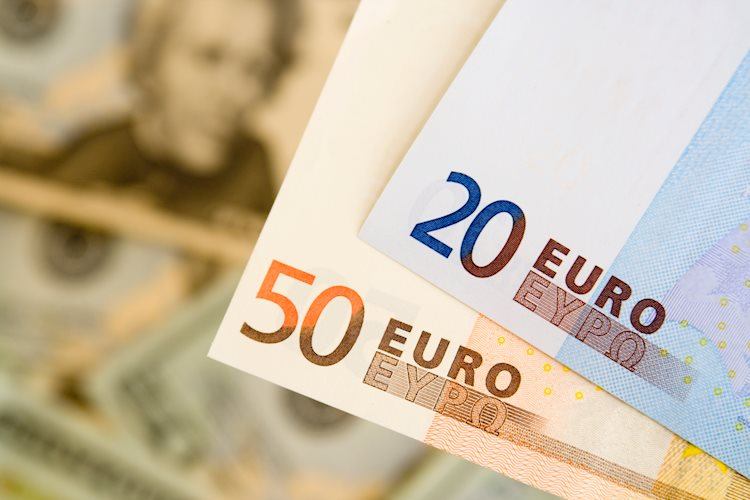- EUR/USD gains ground as the Fed is expected to continue its policy easing in November.
- CME FedWatch Tool suggests 42.9% odds of a 25 basis point rate cut and 57.1% odds of a 50 basis point cut in November.
- Lower inflation in France and Spain has increased the likelihood of the ECB’s rate cut in October.
EUR/USD kicks off the week by edging higher, trading around 1.1170 during the Asian session on Monday. This upside is attributed to the tepid US Dollar (USD), which could be attributed to rising expectations that the US Federal Reserve (Fed) may continue its policy easing in November.
On Friday, the US Core Personal Consumption Expenditures (PCE) Price Index for August increased by 0.1% month-over-month, falling short of market expectations of a 0.2% rise and lower than the previous 0.2% increase. This result aligns with the Federal Reserve’s outlook that inflation is easing in the US economy, reinforcing the possibility of an aggressive rate-cutting cycle by the central bank. Meanwhile, the Core PCE on a year-over-year basis rose by 2.7%, matching expectations and slightly above the prior reading of 2.6%.
The CME FedWatch Tool indicates that markets are assigning a 42.9% probability to a 25 basis point rate cut by the Federal Reserve in November, while the likelihood of a 50-basis-point increased to 57.1%, up from 50.4% a week ago.
St. Louis Federal Reserve President Alberto Musalem stated on Friday, according to the Financial Times, that the Fed should begin cutting interest rates “gradually” following a larger-than-usual half-point reduction at the September meeting. Musalem acknowledged the possibility of the economy weakening more than anticipated, saying, “If that were the case, then a faster pace of rate reductions might be appropriate.”
Lower-than-expected inflation in France and Spain has increased speculation that the European Central Bank (ECB) may implement another interest rate cut in October. If it occurs, this would mark the third cut in the ECB’s ongoing policy-easing cycle, which began in June. The ECB resumed cutting rates in September after holding them steady in July.
Furthermore, traders would likely observe a slew of economic releases from Germany scheduled for Monday, including preliminary Consumer Price Index (CPI) data for September.
Euro FAQs
The Euro is the currency for the 20 European Union countries that belong to the Eurozone. It is the second most heavily traded currency in the world behind the US Dollar. In 2022, it accounted for 31% of all foreign exchange transactions, with an average daily turnover of over $2.2 trillion a day. EUR/USD is the most heavily traded currency pair in the world, accounting for an estimated 30% off all transactions, followed by EUR/JPY (4%), EUR/GBP (3%) and EUR/AUD (2%).
The European Central Bank (ECB) in Frankfurt, Germany, is the reserve bank for the Eurozone. The ECB sets interest rates and manages monetary policy. The ECB’s primary mandate is to maintain price stability, which means either controlling inflation or stimulating growth. Its primary tool is the raising or lowering of interest rates. Relatively high interest rates – or the expectation of higher rates – will usually benefit the Euro and vice versa. The ECB Governing Council makes monetary policy decisions at meetings held eight times a year. Decisions are made by heads of the Eurozone national banks and six permanent members, including the President of the ECB, Christine Lagarde.
Eurozone inflation data, measured by the Harmonized Index of Consumer Prices (HICP), is an important econometric for the Euro. If inflation rises more than expected, especially if above the ECB’s 2% target, it obliges the ECB to raise interest rates to bring it back under control. Relatively high interest rates compared to its counterparts will usually benefit the Euro, as it makes the region more attractive as a place for global investors to park their money.
Data releases gauge the health of the economy and can impact on the Euro. Indicators such as GDP, Manufacturing and Services PMIs, employment, and consumer sentiment surveys can all influence the direction of the single currency. A strong economy is good for the Euro. Not only does it attract more foreign investment but it may encourage the ECB to put up interest rates, which will directly strengthen the Euro. Otherwise, if economic data is weak, the Euro is likely to fall. Economic data for the four largest economies in the euro area (Germany, France, Italy and Spain) are especially significant, as they account for 75% of the Eurozone’s economy.
Another significant data release for the Euro is the Trade Balance. This indicator measures the difference between what a country earns from its exports and what it spends on imports over a given period. If a country produces highly sought after exports then its currency will gain in value purely from the extra demand created from foreign buyers seeking to purchase these goods. Therefore, a positive net Trade Balance strengthens a currency and vice versa for a negative balance.
Read the full article here

